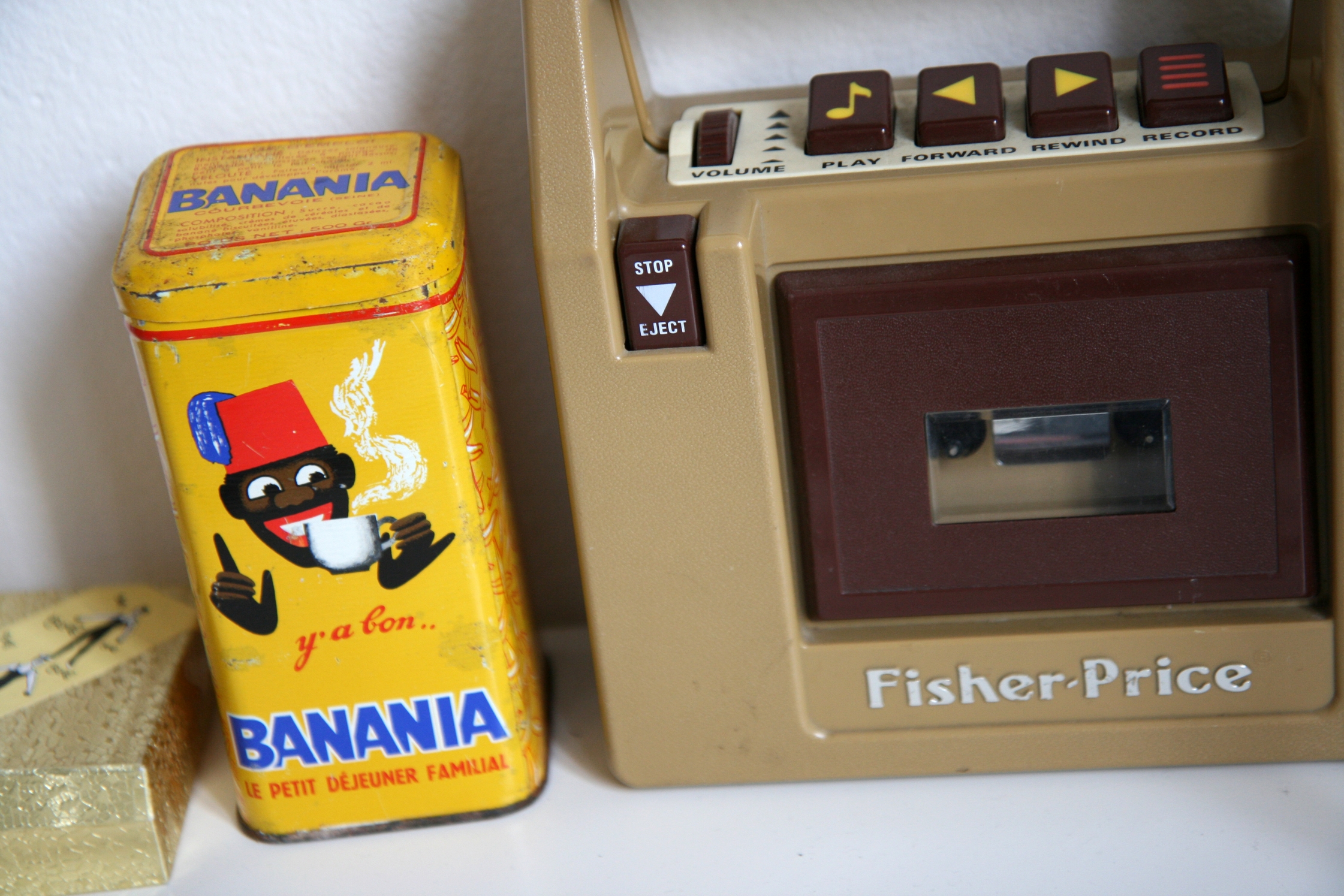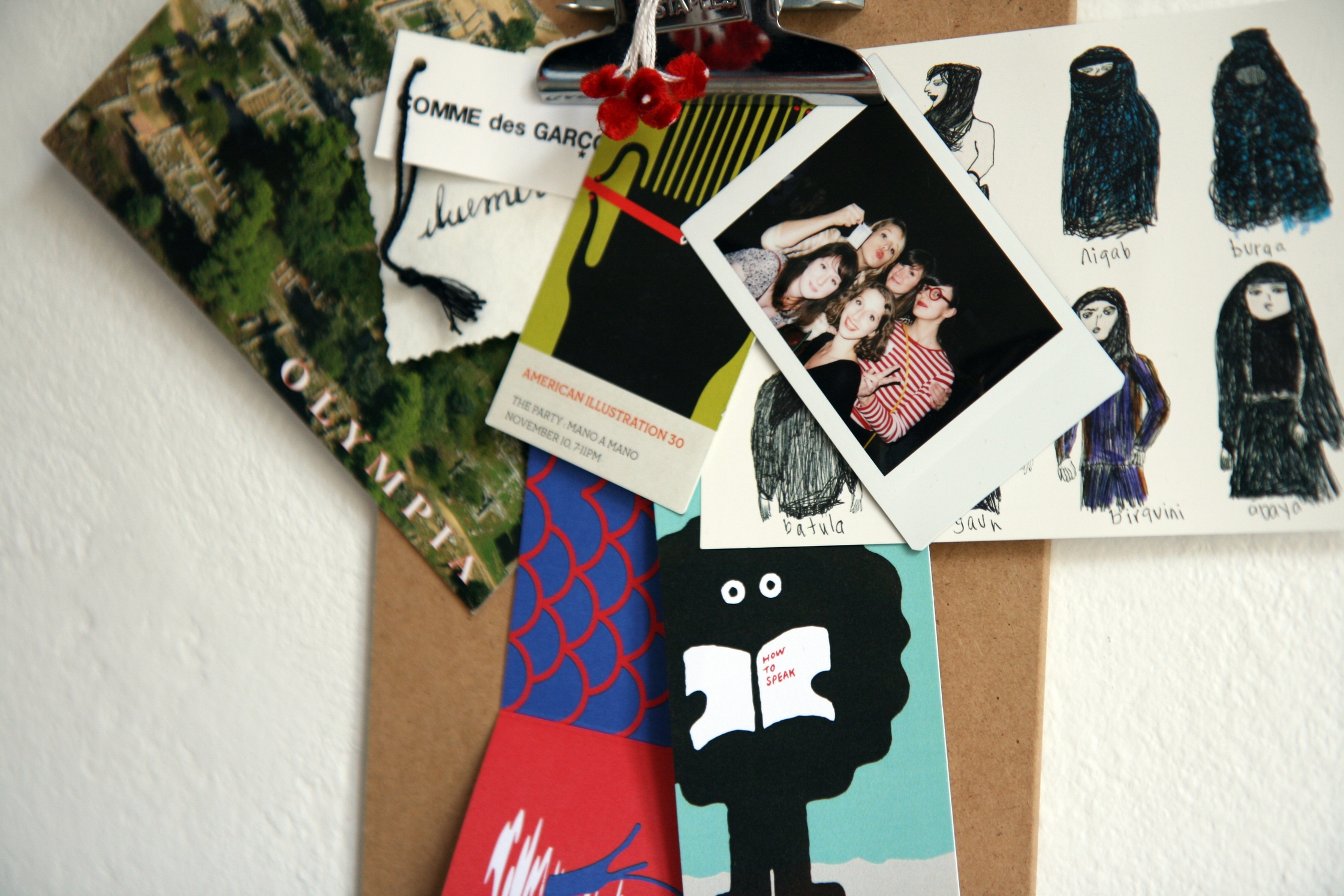One hopes for that specific kind of vibrancy resting in every little corner of an illustrator’s home – walking into Olimpia Zagnoli’s airy apartment in Milan’s Quartiere Navigli neigborhood, one can’t help but feel nourishment of the senses: from the sparse but carefully arranged vintage toy collections, illustrated French postcards, budding potted planters on a simple and a sturdy dining table. Not one object grabs your attention more than another: groups of similar items, whether they’re instruments, plants, books, or frames, all exist in harmony as would a colony of community-minded residents. Just like Olimpia’s characteristic illustrations, there is a place for every punctuating quirk and a place for empty space.
While she served us foccacia and sweet tea over the din of clanking tram cars passing outside, Olimpia talked about her trajectory from being a shy girl that liked to draw to an illustration powerhouse. Her work weekly graces ‘The New Yorker’s’ print and online editions, the ‘New York Times,’ as well as is featured internationally in a brand campaign for Clinique and design collaborations with publishers. Even though Olimpia possesses the obvious option to flaunt around her celestial-like clients, she still embodies a humble girl who remembers well her very first steps into the New York Times’ office in Times Square and what it was like to cluster one rejection after another.
































Where did you study to become an illustrator?
I took a three-year course at the IED in illustration and animation. Back then, the teachers didn’t tell you what was going on in the world of illustration, outside of school. There wasn’t a lot of respect or even a big market for illustration in Italy. We were really clueless. I got started looking for a job out of school to illustrate children’s books. A challenge for me was putting together a portfolio, which looking at it now causes me huge embarrassment.
What kind of book was it that you illustrated?
I was asked by the art director of the New York Times to make their cover – I was very honored of course. It features work by international illustrators, not just American, even thought it’s titled American Illustration. We started from the idea of having the sketches printed on tracing paper, so it looks like real pencil sketches but it’s not. That was last year, and it was pretty cool.
How did you find your agent and what kind of projects do you usually work on?
I usually do more editorial stuff, like this cover of AdWeek. I have an agent in New York and in France. When I began, the market for illustration wasn’t very good. In Italy we had a big moment in the 80s for illustration – a lot of people worked for Alessi and Swatch. But then, illustration wasn’t charming anymore. When I started, I couldn’t find any place to begin. I didn’t know whether I should go into advertising or editorial or children’s books. At school, they don’t teach you how the real world works. My professors were very knowledgeable about what they do but they didn’t teach me what to do. My friends in New York at SVA are very up-to-date and they know the market, so they’re more well informed. But for me it was very difficult.
So how did you get started on your professional career?
I started putting together a portfolio and contacting everyone. I didn’t get any responses. I remember that I was very shy in the beginning. It really changed me in terms of my character and personality. I worked a lot on my shyness, I actually started calling people and became a monster of communication. I used to go to publishing houses and leaving my card in their mailbox, and sending stuff everywhere. I was very into DIY communications. And then I don’t remember when suddenly I had this idea – I thought I really wanted to go to New York, in 2008. I left with my portfolio at the time, and this friend of mine, Gary Taxali – we met on the internet – that was one of those lucky events, I told him I was leaving for New York and asked him if he could recommend any people for me to meet. He gave me the email of an art director of the New York Times, who is now working for Marni. So I wrote him an email, but I was used to how things were going here and thought nobody would respond to my email. Two days later, I got an email saying OK let’s meet Tuesday at 4pm. So I went to his office at Times Square.
What were you feeling at that moment?
I don’t know, like “This is not happening.” So I went there and you have to speak with the guard and get a pass. I’ve never had that kind of experience before, entering a big publishing house like that. It took me 20 minutes to get my pass. So I went to the New York Times floor and got to show him my portfolio for like 3 minutes and left, and was thinking “Oh my God, what’s going to happen now.” My english wasn’t very good at all. It was very scary even though he was very nice. I left and thought “at least I got the experience.”
Maybe two weeks later, I got the first assignment for the open page, which was black and white and very small. I was back in Milan and remembered I had a lot of problems with the time difference – they wanted a sketch by 3pm New York time, and I totally messed it up. This experience probably gave me a lot of confidence because I wasn’t sure what I wanted to do at the time. I went back to New York and started contacting more people and I was more ready to explore that field. I started meeting more illustrators and working with The New Yorker, which was my dream. I have books and books of their illustrations. I was very honored.
Do you ever feel like Illustration isn’t taken seriously?
Yes, all the time. For example, in Italy – even with my parents or people around me, it’s very difficult to be taken seriously. You’re always sketching and drawing all the time and it looks like something kids do. This pamphlet is something I did last year for Rolling Stone magazine, it was a special insert for kids. We made some games for kids, like masks and connecting-the-dots. We’re going to do another one this year. It’s very cool to mix projects for kids and adults, the audience is varied.
What are some of your inspirations? Mood, colors?
I’m inspired by what I saw as a kid, all of the references I saw. I was very lucky because my parents were into the arts. My dad is a photographer and my mom is a painter, so I got to see a lot of exhibitions. I was very lucky because of that. A lot of things I’m doing now comes from there. From Keith Haring to other artists I saw in museums, whatever really impressed me as a kid. Now, I’m not necessarily inspired by art or illustration, but fashion really interests me and it’s really inspiring in terms of colors, textures, and shapes. When new collections come out – I’m not a super fan of fashion, I tend to wear the same things all the time. But when themes and colors and concepts come out, it’s so fast and interesting. Every year you can have different ideas and influences. Also, I think music is very interesting, you can pick things from the 60s or 70s and it can be contemporary at the same time. My biggest challenge is taking from the retro decades and making it contemporary. I think it’s very important to speak the modern language – mixing things from the past and creating a new language.
The past seems to have a profound influence on your work.
When you see so many graphic artists, illustrators, and painters from the 50s, it’s inspiring to see how they made it, but then you realize that’s not what people want now. That’s quite challenging. I see this every time you find an obstacle, for example creating an image – working on a text you hate or dealing with stuff you don’t know anything about – it’s very interesting to avoid the boring stuff and make a new image that can be fun and communicative. Maybe it won’t be the best illustration ever but it could be a different point of view.
Do you have any favorite artists? Contemporary or from the past.
I really like the work of this artist – a folk artist from California who’s living in Nashville. Her name is Jennifer Ullman. I really like the fact that she’s not a professional illustrator or artist and she started making work as therapy. I like outsider art because none of them were born to be an artist. They started being artists for therapy or as a response for something that happened to them. Or like being in jail for 10 years. Every time I go to New York I go to the Folk Art Museum. That is very inspiring. I can’t tell you my “favorite” artist, some of them are anonymous but this is my favorite genre. I really like pop artists in general. Everything is pop for me.
What interests you most about fashion, and how do you arrange your ideas?
I found a lot of textiles from the 70’s and late 60’s, and from collecting vintage clothes with flower patterns and stripes and crazy faces. I started collecting them and the more I see that they translate into my illustrations sometimes. You see so many things and you don’t realize that in a way they’re already a part of you. Sometimes I look at a piece I did and don’t realize the color came from a shirt that I saw two months ago, which I had basically absorbed. I don’t have to have it on my computer to see that I used it in my work. I think it’s also cool to see how Prada shoes, psychedelic art, folk art, can stay in your consciousness and manifest in some way.
Olimpia, thank you so much for your time and this truly interesting interview.
Have a look at her official website, to see how her unique take on illustration is applied for clients such as Vice, Marie Claire and the New York Times.
Interview: Yan Yan Huang
Photography: Marco Annunziata
